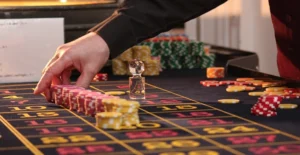I’ve been exploring various ways to make events, parties, and even everyday gatherings more engaging. It seems like a simple spinning wheel can change the whole vibe. People seem to get more involved, and it adds a bit of fun surprise to things. I’ve gathered some ideas for spin-the-wheel game concepts that I think are pretty neat and could work for a lot of different situations.
Key Takeaways
- Spinning wheels are a great way to get people involved and add excitement to any event, from parties to work meetings.
- You can use these wheels for all sorts of things, like picking who answers a question in class or deciding what to do on a weekend.
- For businesses, prize wheels can draw attention at trade shows or boost sales with flash promotions.
- Making your wheel is pretty straightforward, whether you prefer a physical one or using an online tool.
- Adding humor and surprise elements to your wheel game makes it more memorable and engaging for everyone involved.
Why Spin the Wheel Games Are a Must-Try for Any Occasion
Spin the wheel games are fantastic for just about anything. I’ve found them to be incredibly versatile, whether I’m planning a birthday party, a corporate event, or even just a casual get-together with friends. They add this element of surprise and fun that you just don’t get with other activities. It’s like a mini-lottery, but you control the prizes and the theme, which is pretty neat.
Adds Excitement and Engagement
One of the biggest draws is how much excitement they build. When people see that wheel, they immediately want to give it a spin. It’s a simple concept, but it gets people involved. I remember using one at a company picnic, and it was the main attraction all afternoon. Everyone was talking about it, and people who normally wouldn’t interact were chatting and laughing together.
Versatility for Different Settings
What I really appreciate is how adaptable these games are. You can tailor the wheel to fit any occasion. For a birthday, you might have segments for “Gift Card,” “Extra Cake,” or “Sing a Song.” For a trade show, it could be “Discount Coupon,” “Free Swag,” or “Enter Grand Prize Draw.” This flexibility means you can use the same basic game structure in so many different ways. It’s a great way to make any event memorable, from casual parties to more formal gatherings. If you’re looking for a way to liven up a get-together, consider something like casino table games.
Simple to Understand and Play
Another great thing is that they’re super easy for anyone to understand. There’s no complicated rulebook or strategy to learn. You just spin, and whatever it lands on, that’s what you get. This makes them perfect for mixed crowds with different ages and interests. Even if someone is a bit shy, the simple act of spinning the wheel can be enough to get them participating.
Creates Memorable Moments
Ultimately, these games create fun memories. Whether someone wins a big prize or just a silly consolation, the experience of spinning the wheel is often what people remember most. It’s a shared experience that brings people together and adds a unique flair to any event. It’s a simple, effective way to make your occasion stand out.
The real magic of a spin the wheel game lies in its ability to generate anticipation. The visual of the spinning wheel, often accompanied by sound effects, creates a moment of suspense that captivates everyone watching. This shared anticipation is a powerful tool for bringing people together and making an event more engaging.
Creative Spin the Wheel Game Ideas for Parties and Events
When planning a party or any kind of get-together, a spin the wheel game can really liven things up. It’s a simple concept, but it adds a layer of excitement and unpredictability that gets everyone involved. I’ve found that the key is to tailor the wheel’s content to your specific event and guests.
For a more casual party, you could create a “Truth or Dare” wheel. You can either write “Truth” or “Dare” on different segments, or go more specific with actual questions or dares. Another fun idea is a “Magic 8-Ball” style wheel where you fill each segment with different responses to questions your guests might have. It’s a great way to get people talking and laughing.
If you’re hosting a dinner party and can’t decide what to make, a “What’s for Dinner?” wheel is perfect. You can fill it with different meal options or even types of cuisine. It takes the pressure off and adds a bit of fun to meal planning.
Here are a few more ideas I’ve tried:
- “Act It Out” Wheel: Write down short scenarios or movie titles on the wheel. Guests spin, get a scenario, and then have to act it out for others to guess. It’s hilarious to see people’s interpretations.
- “Never Have I Ever” Wheel: Populate the wheel with “Never Have I Ever” statements. When the wheel lands on a statement, the person who has done that thing has to take a sip of their drink or perform a small forfeit.
- “Random Activity” Wheel: Fill the wheel with various activities you might want to do, like “Listen to music,” “Tell a joke,” or “Share a happy memory.” It’s a good way to break the ice and discover new things to do together.
The real magic of these games is in the shared experience. It’s not just about winning a prize; it’s about the laughter, the surprises, and the moments created when everyone is focused on that spinning wheel. It’s a simple way to make any gathering more memorable.
For those looking to add a bit of structure or a competitive edge, you could even incorporate a point system. For example, in an “Act It Out” game, guests could earn points for how quickly their team guesses the scenario. This adds another layer of engagement, especially if you have a prize for the overall winner. It’s amazing how a simple spinner can transform a regular get-together into something truly special, much like how the design of a roulette wheel contributes to its game’s appeal.
Prize Wheel Ideas to Boost Engagement at Trade Shows and Promotions
When I’m at a trade show or running a promotion, I always look for ways to get people to stop and interact. A prize wheel is a fantastic tool for this. It’s not just about the prizes, though that’s a big part of it. It’s about creating a moment of fun and anticipation. People are drawn to the visual of the spinning wheel and the chance to win something, anything, really.
Engaging Prize Wheel Segments
I’ve found that the segments on the wheel itself need to be thought out. You can’t just put random stuff on there. I like to mix it up. We’ll have some smaller, instant-win items like branded pens or stickers. Then, a few mid-tier prizes, maybe a discount on our main product or a small gift card. And of course, one or two big-ticket items that really get people excited. The key is to offer a range of rewards that appeal to your target audience. It’s also a good idea to include a ‘spin again’ or ‘try again’ segment to keep people engaged even if they don’t win a major prize right away. It’s all about keeping that momentum going.
Incorporating Humor and Surprise
Humor is another element I really lean into. People remember things that make them laugh. So, I’ll often add some wacky prizes – maybe a silly hat related to our industry or a funny desk toy. Even the descriptions for each segment can have a bit of a joke or a pun. Having a host with a good sense of humor to run the wheel can also make a huge difference. They can keep the energy up and entertain the crowd while they wait for their turn. Surprise elements, like a sudden ‘double or nothing’ opportunity, can also add a fun twist. It’s about making the experience memorable, not just transactional. For example, we once had a segment that said, ‘Spin again for a chance to win bragging rights!’ It got a good laugh.
Successful Prize Wheel Examples
Looking at what others have done is always helpful. Amazon’s “Spin & Win” on their app is a good example of how to drive engagement with rewards like discounts or credits. Starbucks’ “Summer Game” is another one; they use a virtual wheel to give away free drinks or bonus stars, which really encourages people to keep coming back. Even McDonald’s Monopoly, while not a direct wheel game, uses that same principle of chance and reward to keep customers hooked. These campaigns show that when done right, a prize wheel can really boost customer interaction and sales. It’s a simple concept, but incredibly effective when you think about how to apply it to your own brand. If you’re looking to create your own custom wheel, companies like The ODM Group can help design one that fits your brand perfectly. They understand how to make a promotional wheel that’s both eye-catching and functional for events like trade shows.
The goal is to create a positive, memorable interaction that associates your brand with fun and excitement. It’s not just about giving away prizes; it’s about creating an experience that people want to be a part of and talk about later. A well-executed prize wheel can be a powerful marketing tool, driving foot traffic and generating leads in a way that traditional methods often can’t match. It’s a simple yet effective way to capture attention in a busy environment.
Customizing Your Promotional Wheel
When I’m planning a campaign, I always think about how the wheel itself looks. A custom wheel that matches our brand colors and logo makes a big difference. It’s not just a game; it’s a branding opportunity. Companies that specialize in promotional products, like The ODM Group, can help create a wheel that’s visually appealing and durable. They can tailor it to your specific marketing messages, ensuring it stands out. It’s worth investing in a good quality wheel because it’s often the centerpiece of the activity. The design needs to be clear, the segments easy to read, and the overall look professional yet fun. It’s about making sure the physical representation of the game aligns with the brand image you want to project.
Fun Spin the Wheel Challenges for Family Game Nights

Family game nights are a fantastic way to bond, and a spin the wheel game can really liven things up. Instead of just playing the same old board games, I like to create custom wheels for different challenges. It adds an element of surprise and keeps everyone on their toes.
Truth or Dare Twist
We’ve all played Truth or Dare, but putting the prompts on a wheel makes it way more interesting. You can have a mix of silly truths and mild dares. For example, a truth could be “What’s your most embarrassing childhood memory?” and a dare might be “Do your best impression of a celebrity.” It’s a great way to learn new things about each other.
Chore Challenge Wheel
Let’s be honest, getting kids to do chores isn’t always easy. I made a chore wheel with different household tasks. When the wheel lands on a chore, whoever’s turn it is has to do it. We even added a “Free Pass” segment for those really tough days. It makes chores feel less like a burden and more like a game.
“What If” Scenarios
This one is purely for laughs. I fill the wheel with hypothetical “What if” questions. Things like, “What if you could only eat one food for the rest of your life?” or “What if you woke up with superpowers?” We then go around and answer the question that the wheel lands on. It sparks some really funny conversations.
Movie Charades
For a more active challenge, I create a movie charades wheel. Each segment has the name of a movie. We spin the wheel, and the person who spun has to act out the movie for the rest of us to guess. It’s surprisingly hard to act out a movie title without speaking!
Using a spin-the-wheel game for family night is all about adding a bit of unpredictability. It breaks the routine and encourages participation from everyone, even the shy ones. Plus, you can tailor the challenges to your family’s specific interests and inside jokes, making it a truly personal experience.
Here’s a quick look at how we’ve used it:
- Movie Charades: Acting out film titles.
- Chore Wheel: Assigning household tasks.
- Truth or Dare: Posing questions and challenges.
- “What If” Scenarios: Answering funny hypothetical questions.
It’s a simple concept, but it really does make game night feel fresh and exciting. You can even try a card roulette if you don’t have a physical wheel handy.
Educational Spin the Wheel Activities for Classroom Learning
When it comes to making learning stick, sometimes a traditional lecture just doesn’t cut it. I’ve found that incorporating interactive elements can really change the game for students. Spin the wheel activities are fantastic for this. They add an element of surprise and fun that can make even the most complex subjects more approachable. It’s a simple way to break up the monotony and get students actively participating.
Student Selector
This is a straightforward way to call on students. I fill the wheel with the names of everyone in the class. When it’s time to answer a question or present a topic, I give the wheel a spin. Whoever it lands on gets their moment in the spotlight. It’s fair and removes any perception of favoritism.
Alphabet Challenge
For subjects like vocabulary, science, or geography, an alphabet wheel is brilliant. I create a wheel with letters of the alphabet. Students spin the wheel and then have to name something related to the current lesson that starts with that letter. For instance, if we’re studying animals, a spin might land on ‘Z’, and a student would need to name a creature starting with Z.
Math Fact Practice
Math can be a tough subject for some, so making practice engaging is key. I set up a wheel with different math operations (addition, subtraction, multiplication, division) and another wheel with numbers. A student spins both, and then has to solve the resulting equation. It’s a quick way to reinforce basic math skills.
Vocabulary Builder
Similar to the alphabet challenge, this focuses on words. I populate the wheel with vocabulary words we’ve recently covered. A student spins, and then must define the word, use it in a sentence, or even act it out. This helps solidify their understanding and recall.
Using a spin the wheel in the classroom isn’t just about novelty; it’s about creating a dynamic learning environment where students are encouraged to think on their feet and engage with the material in a memorable way. It’s a tool that can be adapted for nearly any subject matter.
History Timeline Game
For history classes, I create a wheel with significant historical events or periods. Students spin and then have to place the event on a timeline or explain its importance. This helps them grasp the sequence and context of historical happenings. You can find great resources for historical dates and events to populate your wheel, making it easier to prepare your lessons.
Science Concept Review
In science, the wheel can be used to review concepts. I might put different scientific terms on the wheel, and students have to provide a definition or an example. Alternatively, I could put experimental steps on the wheel, and students have to put them in the correct order.
DIY Spin the Wheel: How to Create Your Own Game at Home
Creating your own spin the wheel game at home can be a really fun project, and it’s not as complicated as you might think. I’ve found that making something custom really adds a personal touch to any event or game night. Plus, you have complete control over what goes on the wheel, which is a big plus.
Materials You’ll Need
To get started, you’ll want to gather a few basic supplies. I usually grab:
- A large piece of sturdy paper or thin cardboard
- A pencil and ruler
- Scissors
- A marker or colored pens
- Something to make the spinner itself (more on that in a bit)
Crafting the Wheel
First, you need to make the wheel itself. I usually start by drawing a large circle. Sometimes I trace around a big bowl or even a dartboard if I want a really substantial wheel. For smaller ones, a protractor works well. Once you have your circle, use your ruler to divide it into equal sections. The number of sections depends on what you want to put on your wheel. For example, if you’re making a game for kids, you might want more sections with different activities.
Next, write or draw your options in each segment. It’s best to write them near the edge of the segment so the spinner doesn’t cover them up when it lands. I like to use bright colors to make it more visually appealing.
Making the Spinner Work
This is where it gets creative. There are a few ways to make the spinner part:
- The Pin and Paperclip Method: Push a pin through the narrow part of a paperclip and then into the center of your wheel. Don’t push the pin in, so the paperclip can spin freely. This is a pretty reliable method.
- The Fidget Spinner Method: If you have a fidget spinner, you can use a bit of Blu-Tack to stick it to the center of your wheel. Make sure it has enough lift to spin without dragging. You’ll want to mark one of the arms so you can tell where it stops.
- The Pencil Method: This is the simplest. Just poke a pencil through the center of the wheel and spin the whole thing. It’s quick, but sometimes the results aren’t as precise.
The real charm of a DIY spin the wheel is the ability to tailor it exactly to your needs. Whether it’s for a family game night, a classroom activity, or even just deciding what to watch, you control every element. It’s a simple way to add a bit of unpredictability and fun.
Choosing Your Game
Once the wheel is made, you need to decide what the game is about. You can fill the wheel with anything – names for a student selector, chores for kids, or even different movie genres. I recently made one for my friends to decide on our next board game, and it worked out great. It’s a fun way to make decisions, kind of like the Wheel of Fortune board game but with your own personal twist.
Some ideas I’ve tried include:
- Activity Wheel: Fill it with different activities like ‘read a book,’ ‘go for a walk,’ or ‘bake cookies.’
- Question Wheel: Write down conversation starters or trivia questions.
- Decision Wheel: Use it for simple choices like ‘pizza or tacos?’ or ‘watch a comedy or a drama?’
Making your own spin the wheel is a rewarding project that brings a lot of enjoyment. It’s a fantastic way to get creative and add a unique element to your gatherings.
Best Online Spin the Wheel Tools and Apps for Virtual Events

When hosting virtual events, keeping everyone engaged can be a bit tricky. I’ve found that using online spin the wheel tools is a fantastic way to inject some fun and interactivity. These digital wheels are super versatile and can be used for a bunch of different things, from awarding prizes to just breaking the ice.
Top Online Spin the Wheel Tools
When I’m looking for a good online spinner, I usually check out a few key features. It needs to be easy to set up, customizable so I can match it to my event’s theme, and ideally, it should offer some cool visual effects to make it more exciting. Here are some of the ones I’ve had good experiences with:
- Wheel Maker // Spin the Wheel – Random Picker: This one is pretty straightforward. You can create custom wheels for pretty much anything, whether it’s for a game, a giveaway, or just to make a decision. It’s user-friendly, which is a big plus when you’re trying to get things ready for an event.
- Online-Spin-The-Wheel.com: For a simple, no-fuss option, this site is great. It’s perfect for quick decision-making or simple prize giveaways. You can easily input your own text for each segment.
- Picker Wheel: This platform offers a bit more in terms of customization and features. You can add images, change colors, and even integrate it with other tools. It’s a solid choice if you want something a bit more polished.
How to Use Spin the Wheels Virtually
I’ve used these tools in a few different ways for virtual events:
- Prize Giveaways: This is probably the most common use. I’ll fill the wheel with different prizes, and then during the event, I’ll have a participant spin it to see what they win. It adds a lot of excitement.
- Icebreakers: For team-building events or meetings, I’ll put icebreaker questions on the wheel. Someone spins, and then they have to answer the question. It’s a good way to get people talking.
- Randomizing Activities: If I have a list of activities or discussion topics, I can put them on the wheel and spin to decide what we do next. It keeps things unpredictable and fun.
Using these digital wheels can really change the dynamic of a virtual gathering. It’s not just about the prizes; it’s about creating a shared, interactive experience that makes people feel more connected, even when they’re miles apart. I’ve seen it work wonders for keeping energy levels up during longer sessions.
For a more unique take on interactive games, you might even explore options similar to Zoom Roulette, which adds a dynamic visual element to the spinning action, making it even more engaging for participants.
Spin to Win: Innovative Ideas for Retail and E-commerce Promotions
When I think about retail and e-commerce, the first thing that comes to mind is how to get people to actually stop and pay attention. It’s a crowded space, right? That’s where a well-placed spin-the-wheel game can really make a difference. I’ve found that these aren’t just for parties; they’re fantastic tools for grabbing customer interest and driving sales.
Driving Foot Traffic and Online Engagement
For brick-and-mortar stores, a physical prize wheel can be a huge draw. Imagine a customer walking in and seeing a colorful wheel offering discounts, freebies, or even a chance to win a larger item. It’s an instant hook. I’ve seen this work wonders for getting people to come inside, especially during slower periods. Online, it’s just as effective. A spin-the-wheel popup on a website can gamify the experience of signing up for a newsletter or making a purchase. It turns a routine action into something exciting. The key is to make the potential rewards appealing and relevant to your customer base.
Creative Prize Wheel Ideas for Retail
When I’m designing a wheel for a retail promotion, I like to think about what would genuinely excite people. It’s not just about offering discounts, though those are always popular. Consider these ideas:
- Tiered Discounts: Offer a range of discounts, from 5% off to 25% off, or even a chance for a free product.
- Product Bundles: Spin to win a curated bundle of complementary items.
- Loyalty Points Boost: Award bonus loyalty points that customers can use on future purchases.
- Free Shipping Vouchers: A simple but highly appreciated prize, especially for online stores.
- Mystery Prizes: Add a few segments with
Themed Spin the Wheel Games for Holidays and Special Occasions
Holidays and special occasions are perfect times to add a little extra fun, and a themed spin the wheel game can really make an event memorable. I’ve found that tailoring the wheel’s content to the specific holiday or event makes all the difference. It’s not just about spinning; it’s about connecting with the spirit of the occasion.
Christmas Cheer Wheel
For Christmas, I like to fill the wheel with festive activities or small gift ideas. Think segments like “Sing a Christmas Carol,” “Give a Compliment,” “Watch a Holiday Movie,” “Hot Cocoa Break,” or even small prizes like “Festive Socks” or “Candy Cane.” It’s a great way to keep guests entertained during downtime, perhaps while waiting for dinner.
Halloween Haunt Wheel
Halloween is another fantastic opportunity. You could have segments like “Tell a Spooky Story,” “Do a Monster Dance,” “Guess the Halloween Treat” (where you have a covered bowl of candy), or “Wear a Silly Costume Piece.” Prizes could be themed candy bags or small Halloween decorations. It really adds to the spooky atmosphere.
Valentine’s Day Sweetheart Spin
For Valentine’s Day, the wheel can focus on acts of kindness or fun relationship games. Segments might include “Share a Compliment,” “Give a Hug,” “Write a Love Note,” “Plan a Date Night,” or “Share a Favorite Memory.” It’s a sweet way to celebrate connections.
Easter Egg-stravaganza Wheel
During Easter, you can create an “Easter Egg-stravaganza” wheel. This could feature activities like “Find a Hidden Treat,” “Decorate an Egg,” “Share an Easter Joke,” or “Sing an Easter Song.” Prizes could be chocolate bunnies or small Easter-themed toys. It’s a playful addition to any Easter gathering.
General Holiday Ideas
Beyond specific holidays, you can create a general “Holiday Fun” wheel. This might include prompts like:
- “Plan a Holiday Activity”
- “Give a Holiday Gift”
- “Watch a Holiday Special”
- “Listen to Holiday Music”
- “Share a Holiday Memory”
The key is to make the segments relevant and engaging for the specific occasion. It’s a simple way to inject themed fun into any celebration, making it more interactive and enjoyable for everyone involved. I’ve found that even simple additions like these can really boost the mood and create lasting memories. It’s a versatile tool that can adapt to almost any festive event, bringing a unique element of surprise and delight. You can even find inspiration for various holidays on sites dedicated to fun occasions.
Science and Math Spin the Wheel Games for STEM Education
When it comes to STEM education, making learning engaging is key. I’ve found that spin-the-wheel games can be a fantastic way to get students excited about science and math concepts. It’s not just about memorizing facts; it’s about applying them in a fun, interactive way.
Science Spin the Wheel Ideas
For science, you can create wheels focused on different branches or specific topics. Imagine a wheel with segments like ‘Biology,’ ‘Chemistry,’ ‘Physics,’ and ‘Earth Science.’ When the wheel lands on a topic, students could be asked to answer a question related to it, perform a simple experiment, or identify an image. Another idea is to have a wheel with scientific terms, and students have to define them or use them in a sentence. We could even have a wheel with famous scientists, and when it lands on a name, students share a fact about their contributions.
- Element Identification: Spin the wheel to get a chemical element symbol, and students must name the element and its atomic number.
- Scientific Method Steps: Each segment could represent a step in the scientific method (Observation, Question, Hypothesis, Experiment, Analysis, Conclusion). Spin the wheel to see which step students need to explain or provide an example for.
- Animal/Plant Classification: Fill the wheel with different species. Students spin and then have to classify the organism based on its kingdom, phylum, class, order, family, genus, and species.
Using a spin-the-wheel for science can turn abstract concepts into tangible, interactive experiences. It encourages quick thinking and reinforces learning through repetition and variety.
Math Spin the Wheel Ideas
Math can also be made more dynamic with these games. A wheel could feature different operations (+, -, *, /), numbers, or even types of math problems (algebra, geometry, calculus). For instance, a ‘Math Operations’ wheel could have students perform the indicated operation on two numbers drawn from a separate set. A ‘Geometry Shapes’ wheel might require students to identify shapes, calculate their area or perimeter, or list their properties. I’ve also seen success with wheels that present word problems, where the spin determines which problem a student tackles.
- Multiplication Practice: Populate the wheel with numbers 1-12. Students spin twice, multiplying the two numbers they land on. This is a great way to practice times tables.
- Fraction Fun: Segments can be different fractions. Students spin and then have to find equivalent fractions, add or subtract fractions, or convert them to decimals.
- Geometry Challenge: The wheel can list geometric shapes. When a shape is landed on, students might need to calculate its area, perimeter, or identify its key features. You can find some great,simple STEM activities that can be adapted for a wheel format.
These games are not just about getting the right answer; they’re about building confidence and making math less intimidating. The element of chance keeps students engaged and eager to participate.
Icebreaker Spin the Wheel Games for Team Building Activities
Getting a new team together, whether in person or online, can sometimes feel a bit awkward at first. You want everyone to feel comfortable and start connecting, but how do you break the ice? I’ve found that using a spin-the-wheel game is a fantastic way to do just that. It takes the pressure off direct conversation and adds a fun, unpredictable element that gets people talking.
Icebreaker Questions
One of the simplest ways to use a spin wheel for team building is to load it up with icebreaker questions. Instead of just going around the room, have someone spin the wheel, and the question it lands on is the one they answer. This can lead to some surprising and insightful responses that you might not get otherwise. It’s a great way to learn about your colleagues in a low-stakes environment.
- What’s one skill you’d love to learn?
- If you could have any superpower, what would it be?
- What’s your favorite way to unwind after a busy week?
- What’s a book or movie that recently made an impact on you?
Two Truths and a Lie
This classic game is perfect for a spin wheel. You can pre-fill the wheel with “Two Truths and a Lie” prompts. When the wheel stops on a segment, the person whose turn it is shares three “facts” about themselves – two true, one false. The rest of the team then guesses which one is the lie. It’s a fun way to see how well people know each other and to uncover some hidden talents or experiences.
Team Trivia or Fun Facts
For a bit more engagement, you can create a wheel filled with trivia questions related to your industry, company history, or even general knowledge. Alternatively, you could fill it with fun, quirky facts about team members (with their permission, of course!). The person who spins gets to answer the question or guess the fact. It’s a good way to test knowledge and share interesting tidbits.
Using a spin wheel for icebreakers isn’t just about filling time; it’s about creating a shared experience. It gives everyone a chance to participate, laugh together, and start building those important team connections from the very beginning. It makes the initial stages of team formation much more enjoyable and effective.
Remote Team Connection
If your team is spread out geographically, a spin wheel can be a lifesaver for maintaining connection. You can use it for quick “check-ins” where the wheel dictates a fun question to answer, or even for a “remote scavenger hunt” where the wheel names an item people need to find in their home office within a time limit. This adds a playful element to virtual meetings and helps remote employees feel more involved. For more ideas on virtual team activities, exploring resources on online team building can be quite helpful.
Measuring Success: Tracking Engagement and ROI from Spin the Wheel Campaigns

So, you’ve put together a fantastic spin-the-wheel game for your event or promotion. That’s great! But how do you know if it worked? It’s not enough to just have a cool wheel; you need to see what kind of impact it has. I always like to look at a few key things to figure out if my efforts paid off.
Key Metrics to Track
When I’m evaluating a spin-the-wheel campaign, I focus on a few specific numbers. These help me understand what’s working and what could be better next time.
- Participation Rate: How many people spun the wheel? This tells me if the game itself was appealing enough to get people involved.
- Prize Redemption: What percentage of the prizes given out were claimed? This can indicate the desirability of the prizes offered.
- Lead Generation: If the goal was to collect contact information, how many new leads did the game generate? This is a direct measure of its effectiveness for sales or marketing.
- Website Traffic/App Usage: Did the game drive people to a specific landing page or increase usage of an app? I check analytics for spikes during the promotion period.
- Social Shares/Mentions: Were people talking about the game online? Tracking hashtags or brand mentions can show organic reach.
Calculating Return on Investment (ROI)
To really understand the success, I need to look at the return on investment. It’s not always straightforward, especially with intangible benefits, but I try to quantify where I can.
First, I calculate the total cost of the campaign. This includes the cost of the wheel itself (if custom-made), the prizes, any marketing materials, and staff time. Then, I look at the value generated. This could be direct sales from prize winners, the estimated value of new leads, or even the cost savings from increased customer loyalty.
The formula I generally use is: (Value Generated – Campaign Cost) / Campaign Cost * 100%
It’s important to be realistic about the value generated. For instance, if a prize is a discount, I calculate the actual cost of that discount to the business, not the full retail price of the item.
Analyzing Engagement Data
Beyond just the numbers, I also look at the qualitative data. What were people saying? Were they excited? Did they seem confused?
Understanding customer engagement is key. It’s about more than just clicks; it’s about creating a positive interaction that makes people feel good about the brand. This often translates into repeat business and positive word-of-mouth.
I might also track how long people spent interacting with the game or if they tried spinning multiple times. This kind of engagement data, often found in web analytics or through direct observation at events, gives me a fuller picture. For example, if a game is part of a larger gamification marketing strategy, I’ll see how it contributes to overall engagement metrics.
Post-Campaign Review
After the campaign wraps up, I always do a review. I compare the results against the initial goals. Did we hit our targets for participation? Did the ROI meet expectations? This review helps me refine future spin-the-wheel games, making them even more effective. It’s a continuous process of learning and improving.
Embracing the Fun and Versatility of Spin the Wheel Games

As I wrap up this exploration of spin-the-wheel games, I’m struck by just how adaptable and fun these tools really are. It’s not just about the prizes or the chance element; it’s about the shared experience they create. Whether I’m trying to liven up a family game night or find a new way to engage customers at a trade show, a well-designed wheel always seems to hit the mark. The sheer variety of applications, from educational settings to simple decision-making, means there’s a spin wheel for almost any situation.
The Enduring Appeal of Spin Wheels
What makes these wheels so consistently engaging? I think it’s a combination of factors. There’s the visual appeal of the spinning wheel itself, the suspense as it slows down, and the immediate feedback of landing on a segment. It’s a simple, almost primal, form of entertainment that taps into our desire for a bit of luck and surprise. Plus, the ability to customize them means they can be tailored to fit any theme or purpose, making them incredibly versatile.
Making Spin Wheels Work for You
When I’ve used spin wheels, I’ve found a few things that help maximize their impact:
- Keep it Simple: Overly complicated rules or too many options can dilute the fun. A clear, straightforward game is usually best.
- Visuals Matter: A brightly colored, well-designed wheel grabs attention much better than a plain one.
- Involve Everyone: The best spin wheel games are those where everyone gets a chance to participate and feel involved.
- Surprise Element: While prizes are great, sometimes unexpected challenges or fun facts can be just as engaging.
Beyond the Basics: Creative Applications
I’ve seen spin wheels used in ways I never would have imagined. For instance, a friend used a “Sleepover Wheel” to keep a group of kids entertained during a party, with segments for different activities like charades or a silly dance-off. It completely transformed a potentially slow evening into a lively event. It’s a great example of how a simple concept can be adapted for unique situations, like planning a party.
The real magic of spin-the-wheel games lies in their ability to inject spontaneity and joy into any gathering. They break down barriers, encourage interaction, and create memorable moments that people talk about long after the event is over. It’s this blend of simplicity, engagement, and adaptability that makes them such a powerful tool for fun and connection.
Ultimately, embracing the fun and versatility of spin-the-wheel games means being open to trying them in new contexts. I’m always looking for my next opportunity to spin a wheel, whether it’s for a prize, a decision, or just a good laugh.
Frequently Asked Questions
What exactly is a spin-the-wheel game?
I can see that spin-the-wheel games are a great way to add fun and excitement to almost any event, from parties to classrooms. They work by having a wheel divided into different sections, each with a unique outcome, like a prize, a task, or a question. When someone spins the wheel, the section it lands on determines what happens next. It’s a simple concept that can be adapted for many different purposes.
How can spin-the-wheel games make parties more fun?
I believe that spin-the-wheel games are fantastic for parties because they create a sense of surprise and engagement. For example, you can set up a ‘Truth or Dare’ wheel, a ‘What’s for Dinner?’ wheel with different food options, or even a ‘Never Have I Ever’ wheel with questions. These games can get people talking and laughing together.
Can spin-the-wheel games be used for learning in schools?
From my perspective, spin-the-wheel games are incredibly useful in educational settings. I’ve seen them used to pick students to answer questions, to practice spelling by spinning for a letter, or even to act out scenarios. They help make learning more interactive and less like a traditional lecture.
How can I use spin-the-wheel games for work or team building?
Yes, I’ve found that spin-the-wheel games are excellent for team-building activities at work. I can use them as icebreakers with fun questions, or even to decide the order of meeting agenda items. For remote teams, a ‘Remote Scavenger’ wheel where people have to find items in their homes can be a great way to connect.
How do I create my spin-the-wheel game?
I think the best part about spin-the-wheel games is how adaptable they are. You can easily make your own by drawing a circle on paper, dividing it into sections, and writing your ideas in each part. For digital versions, there are many online tools and apps that let you create and customize wheels quickly.
What’s the benefit of using a prize wheel for promotions or trade shows?
I’ve noticed that for promotions and trade shows, a prize wheel is a fantastic way to draw people in. You can offer discounts, freebies, or even bigger prizes. It creates excitement and encourages people to interact with your brand, which is great for getting noticed.
Can spin-the-wheel games help with making decisions?
I find that spin-the-wheel games are perfect for when you can’t make up your mind. For instance, a simple ‘Yes or No’ wheel can help you decide things, or a ‘What’s for Dinner?’ wheel can settle food debates. They take the pressure off making a choice.
What makes a spin-the-wheel game truly engaging and fun?
I believe that adding humor is key to making spin-the-wheel games memorable. This could mean using funny prizes, writing witty descriptions for each section, or having a host with a great sense of humor. Even unexpected elements like a ‘spin again’ option can add to the fun.
Daniel Chase is a seasoned casino analyst and iGaming writer with over 10 years of experience in the online gambling industry. He specializes in game strategy, casino odds, and player-focused reviews. Daniel is passionate about helping players make smarter decisions through transparency, real data, and honest insight.











